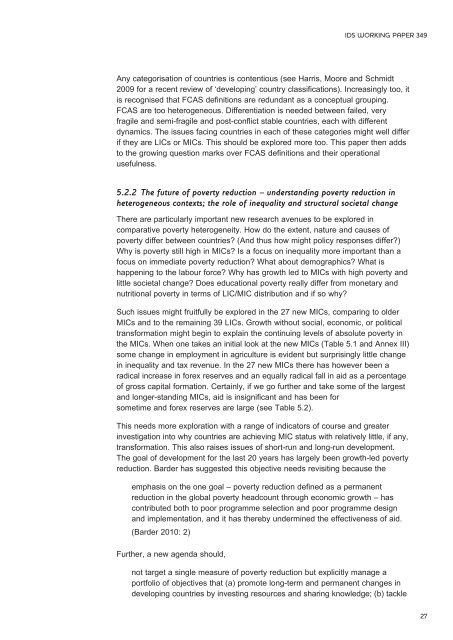Andy Sumner - Institute of Development Studies
Andy Sumner - Institute of Development Studies
Andy Sumner - Institute of Development Studies
You also want an ePaper? Increase the reach of your titles
YUMPU automatically turns print PDFs into web optimized ePapers that Google loves.
IDS WORKING PAPER 349Any categorisation <strong>of</strong> countries is contentious (see Harris, Moore and Schmidt2009 for a recent review <strong>of</strong> ‘developing’ country classifications). Increasingly too, itis recognised that FCAS definitions are redundant as a conceptual grouping.FCAS are too heterogeneous. Differentiation is needed between failed, veryfragile and semi-fragile and post-conflict stable countries, each with differentdynamics. The issues facing countries in each <strong>of</strong> these categories might well differif they are LICs or MICs. This should be explored more too. This paper then addsto the growing question marks over FCAS definitions and their operationalusefulness.5.2.2 The future <strong>of</strong> poverty reduction – understanding poverty reduction inheterogeneous contexts; the role <strong>of</strong> inequality and structural societal changeThere are particularly important new research avenues to be explored incomparative poverty heterogeneity. How do the extent, nature and causes <strong>of</strong>poverty differ between countries? (And thus how might policy responses differ?)Why is poverty still high in MICs? Is a focus on inequality more important than afocus on immediate poverty reduction? What about demographics? What ishappening to the labour force? Why has growth led to MICs with high poverty andlittle societal change? Does educational poverty really differ from monetary andnutritional poverty in terms <strong>of</strong> LIC/MIC distribution and if so why?Such issues might fruitfully be explored in the 27 new MICs, comparing to olderMICs and to the remaining 39 LICs. Growth without social, economic, or politicaltransformation might begin to explain the continuing levels <strong>of</strong> absolute poverty inthe MICs. When one takes an initial look at the new MICs (Table 5.1 and Annex III)some change in employment in agriculture is evident but surprisingly little changein inequality and tax revenue. In the 27 new MICs there has however been aradical increase in forex reserves and an equally radical fall in aid as a percentage<strong>of</strong> gross capital formation. Certainly, if we go further and take some <strong>of</strong> the largestand longer-standing MICs, aid is insignificant and has been forsometime and forex reserves are large (see Table 5.2).This needs more exploration with a range <strong>of</strong> indicators <strong>of</strong> course and greaterinvestigation into why countries are achieving MIC status with relatively little, if any,transformation. This also raises issues <strong>of</strong> short-run and long-run development.The goal <strong>of</strong> development for the last 20 years has largely been growth-led povertyreduction. Barder has suggested this objective needs revisiting because theemphasis on the one goal – poverty reduction defined as a permanentreduction in the global poverty headcount through economic growth – hascontributed both to poor programme selection and poor programme designand implementation, and it has thereby undermined the effectiveness <strong>of</strong> aid.(Barder 2010: 2)Further, a new agenda should,not target a single measure <strong>of</strong> poverty reduction but explicitly manage aportfolio <strong>of</strong> objectives that (a) promote long-term and permanent changes indeveloping countries by investing resources and sharing knowledge; (b) tackle27
















